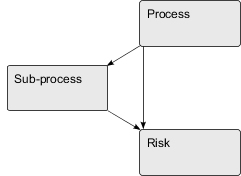Triangle object relationships
Within the triangle, the "top" (parent 1) and "bottom" (child) object types are non-recursive, with the "middle" (parent 2) object type being recursive (such as Sub-Process).
A triangle relationship that includes two recursive object types is not supported.
For example, a report author has a requirement to create a Risk report that allows business users to assess risks associated with various processes and sub-processes within their company.
To provide the report author with easier reporting capability in the framework model, you could configure a triangle relationship between the non-recursive child Risk object and its two related parents: a non-recursive parent Process object and a recursive parent Sub-Process object type, as shown in Figure 1.

The path between the objects forming a triangle relationship must be reflected in a namespace within the reporting framework. For example, a namespace might have the following object type hierarchy configured for Business Entity, Process, Sub-Process, and Risk object types as follows:
SOXBusEntity|SOXProcess,SOXProcess|SOXSubprocess,SOXSubprocess|SOXRisk
To reflect the triangle relationship shown in Figure 1, that namespace would have to be modified to also include the path between Process and Risk objects as follows:
SOXBusEntity|SOXProcess,SOXProcess|SOXSubprocess,SOXProcess|SOXRisk,
SOXSubprocess|SOXRisk
Without the configured triangle, the report author would have to use advanced techniques that may not perform as well to accomplish this task.
To configure triangle object relationships, see Setting the triangle reporting framework object relationships.